Top News
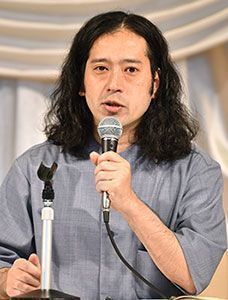
July 12, 2017 Ryukyu Shimpo
The July meeting of the members-only lecture series “Ryukyu Forum” (Ryukyu Shimpo President Junichi Tomita, presiding) took place July 12, at the Hotel Roya Orion in Naha. Comedian and author Naoki Matayoshi lectured on the topic, “Me and Literature,” in which he gave his thoughts on literature as well as his Okinawan an Amami roots.
Matayoshi, who won the Akutagawa Award for literature in 2015 for his novel, Hibana, is known commonly as a “bookworm comedian.” The reasons reading is so appealing for him include, “Because it is simple interesting,” as well as, “generally, the sensations I experience are being drawn out from the power of the author’s words, and the realization of this fact is exhilarating.”
Matayoshi’s father is a native of Nago, and his mother is from Kakeromajima in the Amami Islands. Speaking of episodes from each of his parents’ homes, Matayoshi said of both Okinawa and Amami, “I feel that the power of the islands melts away the boundaries between people,” and looking towards the future, “I think that it would be good to write about the cheerfulness and atmosphere around Okinawan people. I would love to be able to put into words what I feel from my parents and grandmother.”
Regarding his father, who proclaimed, “don’t get carried away,” when Matayoshi got some laughs from dancing in front of his relatives was around 5 or 6 years old, he said, “Because my father did his best to call me out on my bad logic, I became able to wrap all sorts of different situations. The love and support of my parents was key,” he continued, speaking about humor.
(English translation by T&CT and Sam Grieb)
Go to Japanese

July 14, 2017 Ryukyu Shimpo
Correspondent Yukiyo Zaha reports from Washington D.C.
On July 12, the New Diplomacy Initiative (ND), a think tank made up of former Japanese government officials, journalists and others, held a symposium at the East-West Center in Washington, DC. The group proposed an alternative to the plan to relocate U.S. Marine Corps Air Station (MCAS) Futenma to Henoko, Nago on the grounds that Okinawans do not accept the plan. According to their alternative, Futenma would not be relocated within Okinawa. The ND board members who came up with the alternative plan voiced skepticism with the idea that the new base construction being advanced by the Japanese government will contribute to deterrence, and emphasized the military rationality of their alternative, saying it presents an opportunity to consider options besides Henoko.
The symposium, titled “A New Vision for Okinawa and Asia-Pacific Security,” was attended by more than 50 people, including Japanese media and local researchers. Attendees asked questions like whether ND had proposed their plan to the Japanese government, and what effect base closure and realignment will have on the economy.
ND board member Tomohiro Yara proposed that the 31st Marine Expeditionary Unit (MEU), a forward-deployed Marine unit stationed in Okinawa, be relocated outside of Okinawa, and that the “rendezvous point” where the unit meets up with the ships on which it travels be moved to a location outside of Okinawa. Yara stated that if the Japanese government provides a high-speed transport vessel to the U.S. Marines, they will enjoy increased mobility, and through cooperation with humanitarian assistance and disaster relief units from various countries, a 21st century-style security can be realized.
ND member and Tokyo Shimbun editorialist and senior staff writer Shigeru Handa discussed the fact that the Japan Self-Defense Forces have developed new capabilities in recent years and stated, “The time has come to re-think Japan’s national security as a whole.” In 2006, the Japanese and U.S. governments decided to move the command element of the U.S. Marine Corps from Okinawa to Guam, but in 2012 that plan was revised, and Marine Corps combat troops, rather than the command element, are now scheduled to move to Guam. Pointing to the fact that combat troops are in fact planning to leave Okinawa under the current plan, Handa stated, “Talking about ‘deterrence’ is just a means the Japanese government uses to achieve the U.S. government’s aims.”
ND board member and George Washington University professor Mike Mochizuki referred to the possibility of a contingency on the Korean peninsula in light of heightened tensions caused by North Korea’s missile development, pointing out that it would be more effective to position the Marines in Kyushu, which is closer to the Korean peninsula than Okinawa. If the new base construction is pushed forward amidst Okinawan opposition, “Okinawan anger will grow even further, which could put Kadena Air Base at risk,” said Mochizuki.
(English translation by T&CT and Sandi Aritza)
Go to Japanese

July 14, 2017 Ryukyu Shimpo
Riona Higa, a 3rd grade student at Kakazu Junior High School, won her first victory at the girls 13-14 year-old division in the IMGA Academy Junior World Championships held in the United States. She played a total 207 of a 9-under-par 72 in the final day held at Rancho Bernardo CC (5830 yards, par 72) in San Diego, California on July 14, Japan time.
Higa became the second winner of the IMGA Academy Junior World Championships from Okinawa. The first was Mika Miyazato in 2006.
On the final day, Higa started in eighth place, 6 shots behind, but she won the crown with a big comeback.
Higa struggled with her touch on the green because she was inexperienced at playing on the American lawn. However, she maintained her eighth place and stayed within the winning range when she finished the second day.
On the final day, she finished with 7 birdies, no bogey, and won the victory with 1 stroke lead to the second place.
In last year’s competition, Higa was at the top of the leaders board from the first day, but she missed the victory in the playoff after being caught up with five shots on the last day.
Higa said, about the pressure this year, “Last year, at Naha airport, I vowed to win next year and bring the trophy to Okinawa. It was good to be able to carry out what I promised to everyone.”
(English translation by T&CT)
Go to Japanese
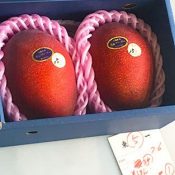
July 7, 2017 Ryukyu Shimpo
Representatives from the prefectural government, JA Okinawa, and Tomigusuku City visited the Ota Market in Tokyo to promote Okinawan tropical fruits such as mangoes in the early morning of July 6. During the bidding, a one-kilogram box with two mangos from Okinawa was priced at 150000 yen. This number far exceeded the price from last year, which was 80000 yen. People attending the market were thrilled that the Okinawan product sold for its highest price in history.
Brokers at the market also enjoyed tasting mango, pineapple, and dragonfruit, as they were pleased with its taste, saying “delicious.” Tsutomu Oshiro, the chair of JA Okinawa said, “this proves that Okinawan mangos produced in a rich natural environment, are highly regarded. The products this year tended to be large with high sugar concentration thanks to good weather. We will do our best delivering the products to the market.”
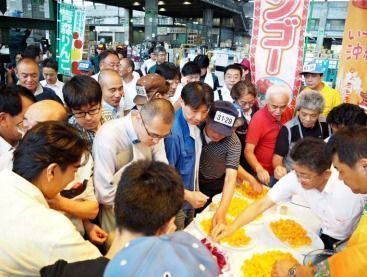
People at the market enjoy tasting Okinawan fruit
According to the prefecture, the estimated harvest of mangoes this year will be 2055 tons. The handling of the products will start around late July.
(English translation by T&CT and Sayaka Sakuma)
Go to Japanese
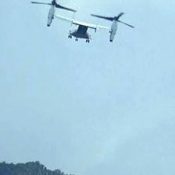
July 11, 2017 Ryukyu Shimpo
At about 2:40 p.m. on July 11, a U.S. Marine MV-22 Osprey aircraft landed and took off from N1 and H helipads, recently built in the Northern Training Area in Higashi and Kunigami villages.
It is the first time the N1 and H helipads have been used for training. The Okinawa Defense Bureau confirmed that the aircraft had landed and taken off from the two helipads. However, the villages had no advanced notification about the training from the defense bureau.
Last year, the construction of the helipads was completed, and as part of a deal, the U.S. government then returned a land area of 4010 hectares, which accounts for about 53 percent of the NTA, to the Japanese side. The two governments agreed to return over half of the land used for the NTA to Japanese side after completing construction of the helipads.
However, the only new circular landing zone in the training area, was completed when the U.S. government returned the land. On July 1, the defense bureau restarted the work to build a link road to G helipad from H helipad.
The defense bureau explained to Higashi Village office that the operation of the new helipads would begin after completion of the entrance road and removal of materials for the construction.
(English translation by T&CT)
Go to Japanese
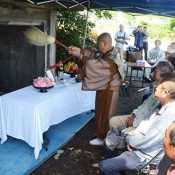
July 10, 2017 Ryukyu Shimpo
Uruma – The demolition of a ganya, a structure used to store a gan prior to a burial, took place in Yonashiroteruma, Uruma on June 24. A gan is a portable shrine used to carry the coffin. In Okinawa, cremation has long since replaced burial as the norm, and as the ganya was last used sometime around 1960, it was decided that it would be demolished. Around 40 villagers gathered, and watched quietly as a monk performed a rite of gratitude as a send-off.
According to Eibun Goya, 95, in Teruma, a gan must be carried by someone other than the relatives of the deceased.
On the day of the funeral procession, after dusk salt would be deposited in an around the house of the deceased for the purpose of purification, and with a whistle see the deceased off one more time, carrying the gan to a crossroads away from the village.
Goya reflected proudly, “Assembling the gan can take up to half a day if one is unaccustomed. Since I am quite good at putting it together, I was always called upon for funeral services.”
Keiko Fukushi, 71, said, “There was a superstition where if a child pointed their finger at a ganya, they would lose their finger, so if they ever mistakenly pointed at one, they had to put their finger in their mouth and hop on one foot in a circle three times. It was also said that after the coffin was lowered into the grave, the dead would follow, so the weight would not change,” looking upon the ganya that was at times scary but had also become familiar to the people in the area.
Hatsune Inafuku, 76, who’s grandmother’s funeral made use of the gan around 1960, said with feeling, “At the time cremation had already become the norm, however my grandfather said, ‘I will not burn her,’ and so my grandmother was carried on a gan. The ganya [being demolished] is a sign of the times.”
(English translation by T&CT and Sam Grieb)
Go to Japanese
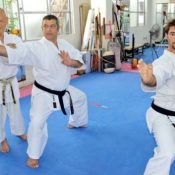
July 11, 2017 Ryukyu Shimpo
Pascal Ibert a Nana-dan (7th rank) practitioner of Okinawa Goju-ryu Karate has been training for 38 years in Dordogne, southern France, where he now teaches about 50 students. For three consecutive years beginning in 2015, he has traveled to Yamashita Town, Naha to Okinawa Goju-ryu Karate Goyukan in order to learn karate Kata (forms) from Anyu Shinjo, a juu-dan (10th rank) practitioner. From June 15 through July 10, he stayed in Okinawa along with Matthieu Carré, one of the pupils from his dojo in France, learning fundamental Kata from Shinjo. They intended to hone their Waza (techniques) and inner strength by training at karate’s birthplace with a local hanshi (a title reserved for the few top experts; a teacher of teachers).
Ibert began his karate training in 1979 after watching demonstrations and matches at a karate tournament in France. Formerly he had experience in Tai Chi Chuan, but through witnessing karate etiquette and the respect shown toward one’s opponent, he perceived that karate has a different philosophy from other martial arts. Looking back on his first time watching karate, Ibert said that he noticed breathing techniques, posture, Kata, and other idiosyncrasies in karate that were not present in other martial arts. He was fascinated.
In July 2015, Ibert first visited Shinjo’s dojo, introduced by an acquaintance. This year he once again received training in traditional karate Kata from Shinjo, who was trained by Eiichi Miyazato, a personal pupil of the founder of Okinawa Goju-ryu Karate, Chojun Miyagi. Shinjo claimed, “It is my duty to teach authentic Kata.” He said that he takes pride in seeing practitioners come all the way from France to train with all their might.
Carré, who has been training at Ibert’s dojo for about ten years, said, “Rather than achieving higher ranks, my goal is to polish my technique and perform flawless demonstrations.”
Ibert said, “Although aspects of teaching are different in France, the Kata and Waza are unchanged. I want to accurately pass on what I have learned [in Okinawa].”
(English translation by T&CT and Erin Jones)
Go to Japanese

July 2, 2017 Ryukyu Shimpo
On June 28, the Chibana Hanaui Business Cooperative visited Mayor Sachio Kuwae at the Okinawa City Office and reported on the production of their original Kariyushi shirts. The Cooperative will work with the Chubu Dressmaking Association to prepare a mass production system in an effort to increase the popularity of Chibana Hanaui. Their Kariyushi shirts, which have previously only been produced custom-made, will now be ready-made so the company can produce large quantities.
Kariyushi shirts are currently limited to 30 pieces. The Cooperative will sell kariyushi shirts giving priority to the staff at the City Office. Then, they will start general marketing for the summer when sales time peaks.
Shirt sizes are M, L, LL, for men only. There are five kinds of colors, each with two collars. Shirts are made of hemp fiber. For the Chibana Hanaui shirts a unique design is used for the breast pocket and collar part with a red and white pattern on the dark blue background.
Chief Executive Kobashigawa said, “80 percent of shipment of textile has been outside of Okinawa. I hope to make Chibana Hanaui popular in Okinawa.”
(English translation by T&CT and Megumi Chibana)
Go to Japanese
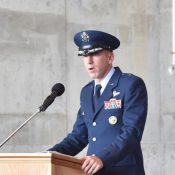
July 10, 2017 Ryukyu Shimpo
Kadena Air Base’s 18th Wing held a change of command ceremony on the morning of July 10, with Col. Case Cunningham relieving Brig. Gen. Barry R. Cornish.
Kadena Town Mayor Hiroshi Toyama, Okinawa City Mayor Sachio Kuwae, Chatan Town Mayor Masaharu Noguni and Okinawa Governor Takeshi Onaga, who were invited to the ceremony, refused to attend, expressing their protest against U.S. military operations, including the use of the former navy aircraft parking apron and the continuation of parachute drop drills despite local opposition.
Col. Case Cunningham worked as a commander at the Creech Air Force Base in Nevada. He has served as commander of air-wing level from squadron level.
(English translation by T&CT)
Go to Japanese
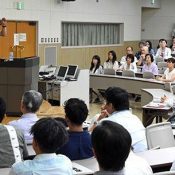
July 7, 2017 by Ryukyu Shimpo
The 93rd Ryukyu University 21st Century Forum was held June 29 at the Ryukyu University Law School in Nishihara. The forum featured musician Kazufumi Miyazawa, who lectured on the topic of, “The future of our island – Kuruchi, uta, and sanshin.” Miyazawa discussed his project which involved performing with a sanshin made with kuruchi (also known as Ryukyu ebony), the wood used for the neck of the sanshin, from a forest which had been raised for 100 years called the “100-year Kuruchi Forest Project.”
At the outset, Miyazawa talked about the making of his famous song, “Shima uta.” He reflected, “I was traveling around Okinawa, visiting places like the Himeyuri Peace Museum and Chibichirigama. I was embarrassed by my complete lack of knowledge about the Battle of Okinawa. There are many people on the main island who do not know much about Okinawa. I sang ‘Shima uta’ with the thought of teaching them.”
With regards to his connection to kuruchi, Miyazawa said, “I heard from someone who worked at a sanshin shop who said that after ‘Shima uta’ became a hit, imports of kuruchi increased, and I felt extremely guilty. I thought there must be something I could do, so I set me gaze towards the planting of Okinawa kuruchi.
In 2012 the Kuruchi Forest Project began, with an executive committee comprised mainly of growers and forest managers. “It will be 100 years until it can become the material for sanshin. After these 100 years, we will have competed the Kurchi Forest. If we can make a sanshin from Okinawan kuruchi, it will mean that during this period, the island will have not experienced war, and will be able to prove it. It is with this in mind that I want to raise these trees,” he said with passion.
After the lecture, Miyazawa played “Shima uta” on a sanshin he made himself. The people who came to listen were intoxicated by Miyazawa’s passionate voice and colorful sanshin.
Also attending the panel were Daiichi Hirata, former chair of the Okinawa Culture Promotion Association, Miki Nakamine, from the Okinawa Sanshin Crafters Co-op, and Professor Shingo Taniguchi, from the Ryukyu University School of Agriculture, all of whom are working with Miyazawa on the project.
(English translation by T&CT and Sam Grieb)
Go to Japanese
July 6, 2017 Ryukyu Shimpo
In regard to the fact that the United States military predicates the return of U.S. Marine Corps Air Station (MCAS) Futenma on the ability to use a civilian airport in case of emergencies, Kiichi Jahana, head of the Executive Office for the Governor of Okinawa, said at a meeting of the Prefectural Assembly on July 5 that he supposes the civilian airport the U.S. government has in mind is likely Naha Airport. He emphasized, “We will absolutely not permit use of Naha Airport [by the U.S. military].” It was the first time a prefectural official made reference to a specific civilian airport that might be used.
Regarding Futenma’s return, at a meeting of the House of Councilors Committee on Foreign Affairs and Defense on June 15, Defense Minister Tomomi Inada stated, “If the requisite conditions for the return of Futenma are not met, it will not be returned.” It was the first time a Japanese defense minister made this remark explicitly, and her comment revealed that MCAS Futenma might not be returned even if the new base in Henoko it is built.
In April, the U.S. Government Accountability Office (GAO) published a report asserting that runways at the planned new Henoko base will not be long enough for the Marines to carry out all of their duties, stating that the U.S. military must be allowed use of another, longer runway on some occasions and indicating that of twelve possible candidates for such alternate runway, one is in Okinawa.
At the July 5 Prefectural Assembly meeting, Mr. Jahana of the Executive Office of the Governor was asked about the one candidate located in Okinawa, and he replied that the Japanese and U.S. governments have not made reference to a specific airport, but added, “The runways at MCAS Futenma are 2,800 meters long, so I imagine they are likely referring to Naha Airport, which has 2,700-meter runways.” He further expressed his opposition to such a plan, stating, “Naha Airport is overcrowded. It is already used by the Japan Self-Defense Forces. There would be a negative impact on tourism. We well absolutely not permit [its use by the U.S. military].” His comments were in response to a question by Assemblyman Shoichi Taira of the “Okinawa” faction.
At the June 5 Prefectural Assembly meeting, Governor Takeshi Onaga emphasized that Defense Minister Inada’s comments constituted an official response, saying that the remark had been confirmed four times at the House of Councilors Committee on Foreign Affairs and Defense meeting. “I experienced extreme shock [at the defense minister’s words],” said Onaga. “This issue [of the conditions for Futenma’s return] was not brought up at all during discussions at the time of [the previous governor’s] approval of the land reclamation permit, yet there was talk of ceasing operations at Futenma within five years. It is incomprehensible,” Onaga stated, expressing his mistrust toward the Japanese government, which had previously made no mention of this condition for Futenma’s return.
The conditions for Futenma’s return were decided as part of a plan to return or consolidate U.S. bases south of Kadena Air Base, which was agreed upon by the Japanese and U.S. governments in April 2013.
(English translation by T&CT and Sandi Aritza)
Go to Japanese











 Webcam(Kokusai Street)
Webcam(Kokusai Street)


